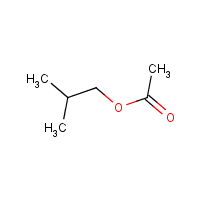Isobutyl acetate
Agent Name
Isobutyl acetate
CAS Number
110-19-0
Formula
C6-H12-O2
Major Category
Solvents

Synonyms
2-Methyl-1-propyl acetate; 2-Methylpropyl acetate; 2-Methylpropyl ethanoate; Acetate d'isobutyle [French]; Acetic acid, isobutyl ester; Isobutyl acetate; Isobutyl acetate (natural); Isobutyl ethanoate; Isobutylester kyseliny octove [Czech]; beta-Methylpropyl ethanoate; [ChemIDplus] UN1213
Category
Esters (<C12)
Description
Colorless liquid with a fruity, floral odor; [NIOSH]
Sources/Uses
Solvent uses include nitrocellulose, thinners, sealants, lacquers, and perfumes; [Hawley]
Comments
A skin, eye, and respiratory tract irritant; Inhalation of high concentrations can cause CNS depression; [ICSC]
Biomedical References
Exposure Assessment
Skin Designation (ACGIH)
Insufficient data
TLV (ACGIH)
50 ppm
STEL (ACGIH)
150 ppm
PEL (OSHA)
150 ppm
MAK
100 ppm
IDLH (NIOSH)
1300 ppm
Excerpts from Documentation for IDLHs
Basis for original (SCP) IDLH: The chosen IDLH is based on the following statements: A 4hour exposure to 8,000 ppm killed 4 of 6 rats [UCC 1971; Smyth et al. 1962 as cited by ACGIH 1971] and no deaths resulted from a 4hour exposure of 6 rats to 4,000 ppm [UCC 1971; Smyth 1964 as cited by ACGIH 1971]. . . . Human data: None relevant for use in determining the revised IDLH.
Vapor Pressure
17.8 mm Hg
Odor Threshold Low
0.36 ppm
Odor Threshold High
3.6 ppm
Lethal Concentration
LCLo (rat) = 8,000 ppm/4H
Explanatory Notes
IDLH = 10% LEL; Detection odor threshold from AIHA (mean = 1.1 ppm); Flash point = 18 deg C; VP from HSDB;
NFPA
may ignite at ambient temp
Adverse Effects
Neurotoxin
Acute solvent syndrome
Diseases, Processes, and Activities Linked to This Agent
Diseases
Occupational diseases associated with exposure to this agent:
Processes
Industrial Processes with risk of exposure: